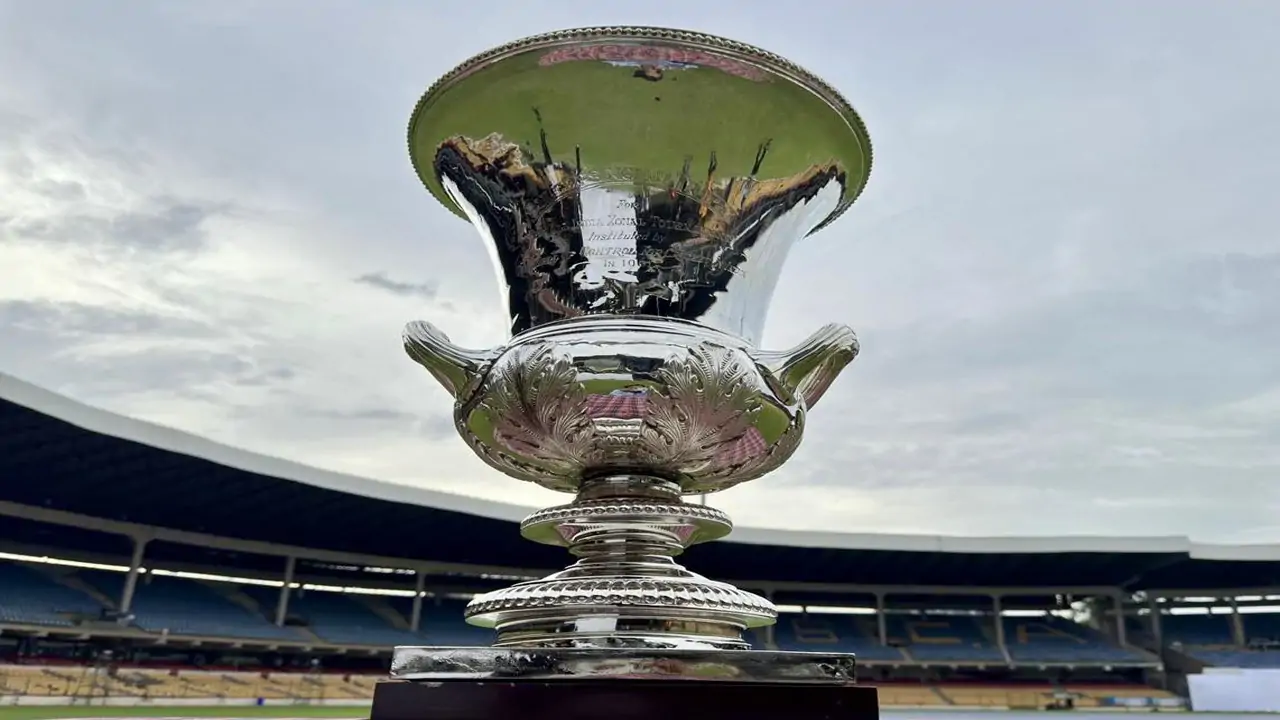How one Ishan Kishan hiatus cascaded into the revival of Indian domestic cricket
Over the past year, a series of BCCI initiatives has attempted to revitalize an Indian domestic circuit that has been struggling for relevance for decades. The saga was sparked by what then seemed an innocuous dispute between Ishan Kishan and the Board that kept culminating into bigger things.

Kishan’s break itself was a non-issue, but his dealings that followed with the Board of Control for Cricket in India had dire consequences. The fiasco truly began with Kishan choosing to remain on the sidelines for the ensuing Test series against England but more importantly, making himself unavailable for Jharkhand in the Ranji Trophy. Things only became worse when he was spotted training in Baroda instead with IPL skipper Hardik Pandya at a private facility.
If you are fit then no excuse will be entertained. This applies to all centrally contracted players, they have to play. The player cannot decide his future, the selectors need to decide that. If the player is good in red-ball, he has to play.
Jay Shah
It was enough for the Indian higher-ups to realize that franchise fever – already a long-ongoing issue for the other Test-playing nations – had begun to tangibly affect their national team too, despite the restrictive policy of barring active players from competing in leagues abroad. Strong statements followed from BCCI Secretary Jay Shah, then-head coach Rahul Dravid, chief selector Ajit Agarkar, and skipper Rohit Sharma, but the true hammer blow came when the governing body excluded Kishan and Shreyas Iyer from the central contracts lists despite the duo being national team incumbents.
BCCI piled on the emphasis on red-ball cricket thereafter by dramatically announcing a ‘Test Incentive Scheme’ after the England series’ conclusion and while the move flew under the radar, it does have some major implications. For instance, India is slated to play 17 Tests in the 2023/24 season. Jasprit Bumrah has missed just one Test of the seven so far – if he plays seven more out of the remaining 10, it would take him past the 75% appearances barrier, thereby boosting his match fee earnings from around INR 1.95 Cr to a staggering INR 7.80 Cr, an increment of 300%.
However, perhaps the greatest initiative the BCCI has taken in their pursuit of ‘saving’ red-ball cricket is revitalizing a faltering Duleep Trophy. It is crucial to understand the purpose of the tournament and how it had evolved to its dilapidated state to recognize the impact of the latest changes.
The Duleep Trophy began as a replacement for the historic inter-faith Bombay Pentangular, played between the major religions of the country. For reasons that seem too obvious now, the competition was converted into a zonal event, to serve as a bridge between the Ranji Trophy and the national team.
However, with the introduction of ‘A’ teams, one-day cricket, and ultimately T20s, the tournament was shunned to the doldrums. Apart from the uncountable format changes, the tournament was scrapped in 2007 and 2015 altogether because of a busy cricketing calendar. The Committee of Administrators (CoA) even made the decision permanent in 2017, only to reverse their stance three days later citing “prestige” – you know things are bad when the country’s top administrators could think of tradition as the only reason to keep a tournament afloat.
The Duleep Trophy has struggled for an identity for decades now, despite a host of attempts to make it relevant again pic.twitter.com/0a5AX1at0O
— SportsCafe (@IndiaSportscafe) September 11, 2024
The declining popularity of the Duleep Trophy can be gauged by the fact that Sunil Gavaskar played 24 games for the West Zone, his successor Sachin Tendulkar only made eight appearances, while current generation players such as KL Rahul and Virat Kohli had only played a couple of editions until 2024. This is exactly what has changed – the tournament now serves a far greater purpose than just keeping Duleepsinhji’s legacy alive, courtesy of a slew of changes.
Firstly, the BCCI has done away with the zonal format wherein state selectors formed committees to pick teams and instead split four teams from a common pool without any age or regional restrictions. This makes for much more balanced teams and competitive cricket rather than the domination of certain zones. It also serves as added motivation for the players, knowing that a few impressive performances might mean a Test cap is on the horizon since the national selectors are directly involved with the tournament.
Secondly, the added emphasis on the tournament has forced the aggregation of the entire Test pool – incumbents and hopefuls alike – for the first time in a decade at least. The opening round of the 2024 tournament featured 17 Test-capped players, including 12 who were either part of the previous Test squad against England or are a part of the upcoming squad to take on Bangladesh. This allows youngsters like Musheer Khan and Sai Sudharsan the unique opportunity to rub shoulders with accomplished international stars and watch their processes from close quarters across four days.
Thirdly, the tournament serves as the perfect testing ground for domestic super talents in all types of situations against truly elite talent. Not only does the level of opposition challenge them physically and technically but also gives a fair account of their mental aptitudes. Bowling to a domestic high-achiever in the Ranji is a whole different gravy than bowling to a Rishabh Pant or a Shubman Gill with a dedicated audience following at home and under the close scrutiny of national selectors. Similarly, the surfaces that were on offer in Bengaluru and Anantapur in the first two rounds proved to be a proper challenge for batters, pacers, and spinners alike, further enhancing the value of performances.
For India squad members such as Axar Patel and Shreyas Iyer, who have been dropped from the playing XI in recent times, the Duleep Trophy is also an ideal stage to stake a claim back in the national side by going head-to-head against their direct rivals for the precious spots.
Last but not least, the tournament’s placement ahead of the home Test season allows the incumbents recovering from injuries to prove their fitness in competitive surroundings. Take Pant for example – big question marks were looming over the wicket-keeper batter’s return to long-form cricket and whether he will be able to sustain the workload of red ball, but his outing in the Duleep Trophy has largely put them to rest. Additionally, it allows regulars such as Jaiswal to get back into the Test mindset and build match readiness, similar to the Australian tradition of scheduling at least one Sheffield Shield round before their home season gets underway.
One might be tempted to argue that regular game time in the Ranji would solve all these issues. However, the idea is impossible in practice and flawed in principle. The current scheduling of international and franchise cricket is as asinine as any professional sport gets, making the participation of national team players – especially all-format players – a pipe dream. In 2022, India played a record 71 internationals, and then nearly bettered the mark the following year with 66 matches. For context, only twice has a Test-playing nation been involved in over 60 encounters in a calendar year – Australia and New Zealand (61) in 2009 and 2023 respectively. Add to that two months of the IPL and it makes for well over 100 days of just cricket, never mind the travelling, rest days between games, training, and post-tournament recovery.
The asinine scheduling of modern-day cricket in numbers! pic.twitter.com/1ktKQ1MH09
— SportsCafe (@IndiaSportscafe) September 11, 2024
This contributes to another problem with the Ranji – a lack of fair competition. Courtesy of the sheer size and population of India, the Ranji Trophy is inevitably split into groups featuring a combination of strong and weak teams, thus allowing players to rack up numbers that only have face value. Add to that the absence of international talent, and the tournament’s standard becomes inappropriate for Test selection. In the latest Ranji season, three of the four elite groups had at least one team that managed less than 10 points, including four teams that went winless – Manipur in Elite Group A ended up losing all their seven games.
In fact, the dropping standards of Ranji have even forced the BCCI to rely on the IPL to judge a player’s ability since it is the only domestic tournament at present featuring a high quality of talent and experience. Delegating this role to the Duleep Trophy would not only reduce arbitrary picks for the Test team such as Suryakumar Yadav and Ishan Kishan but also fast-track younger talents like the Khan brothers, Sarfaraz and Musheer. At the very least, it gives the Indian selectors a definite idea of the quality of their backup options and helps shore up the reserves more efficiently. This adds an element of transparent meritocracy to the selection process too, which increases the confidence of players on and around the fringe.
Even if the selectors are inclined towards a templated pick, similar to what England have done with their tall spinners, aggressive batters, and 85 mph+ quicks, the Duleep Trophy can be the ideal litmus test. The Men in Blue seem to have already trodden that path with the selection of Yash Dayal as the customary left-arm fast bowler in the Test squad, but only after pitting him head-to-head against Khaleel Ahmed while testing Arshdeep Singh in the other Duleep Trophy encounter.
For all the credit that is due to the BCCI for these recent developments, sustainability as always remains key. This isn't the first time the Duleep Trophy has undergone drastic changes and probably won't be the last. Even the zonal format has been banished for the second time, following the introduction of India Red, Green, and Blue from 2016-19. The idea remained similar then, but the execution lagged. For instance, the first such edition saw 21 Test players participate, but only two were incumbents with the rest either too young to be in the conversation or the twilight of their careers. Even then, the number reduced to 19 in 2017, 8 in 2018, and 7 in 2019 as the calendar got more crammed.
Interestingly enough, Ajit Agarkar had himself during this duration, in the capacity of a broadcaster, asked the BCCI to make do with the competition. He had an idea of what purpose the Duleep Trophy should serve and has now grasped the opportunity to help implement the same. Whether it will stand the test of time is anyone's guess.

Comments
Sign up or log in to your account to leave comments and reactions
0 Comments